Off-Grid: Complete Solar Power System Flow
July 5th marked our first full year of living off-grid. We generate our own electricity with solar panels, and a backup generator that ran for a hour a day for the two darkest months of winter. We'll be adding more solar panels and batteries before the upcoming winter to lessen the use of the gasoline backup generator.
Why Off-Grid Solar Power ?
I'm not sure how much effect I will have on the natural climate change cycles, but energy Independence is one of the greatest benefits I've found. Not being effected - possibly for days - by storms that knock down power lines - or by electricity price changes. Another motivating benefit is energy cost savings - our calculated monthly bill went from $200 per month to $40 per month. This is including the cost of the current system, and assuming battery replacement at 6 years and solar panel replacement at 20 years. This also includes the family using electricity more efficiently. The solar power system that I am using - My Solar Power Setup - cost $6300.
Current Solar Power System Cost
+$2500 Solar Panels (1000 Watts)
+$500 Solar Charge Controller (60 amp)
+$1700 Deep Cycle 12 Volt Batteries (10 batteries, 800 Amp Hours Total)
+$800 Pure Sine Wave Inverter (2500 Watts)
+$400 Backup Generator (3000 Watts)
+$400 12 Volt Battery Charger (70 amp)
=$6300
Solar Power System Flow
Solar Panels create an electrical charge from light. The solar charge controller converts the electrical charge to a voltage that can charge the 12 Volt Battery Array for storing the energy for on-demand use. The Power Inverter changes the 12 Volt DC Battery power to Standard household voltage Alternating Current for powering household appliances, devices, tools, pumps, fans - and more. A Backup Generator and 12 Volt Battery Charger is used to charge the battery array when there is not enough light for the solar panels in the setup to charge the batteries.
Solar Panels - Mono Vs. Poly
There are two major types of solar panels - Monocrystalline and Polycrystalline. With mono solar panels, the panel acts as one. With poly solar panels, each cell on the solar panel acts independently. When both solar panel types have their entire panel exposed to light - sunny or overcast - the mono solar panel would generate more electricity. If both panels were in half light and half shade - like from a tree - the poly solar panel would generate more electricity. I am using monocrystalline panels because no objects will be throwing shade on any of the solar panels.
How many Solar Panels ?
That depends on the amp hours of battery array storage - and on the amount of sunlight received throughout the year. Currently I have 1000 watts of solar panels charging an 800 Amp hour battery array. In full sunlight the solar panels will fully charge the battery array in about a hour and a half. I live in Ontario, Canada - we have Spring, Summer, Fall, and Winter. In the winter it's dark before 6 PM and as early as 5 PM for two months. Those two dark months are the only months that I could really use more panels to keep the batteries charged. If you live closer to the equator, then you could probably get away with less panels to batteries ratio. If you rarely have clouds where you live, then you could most likely have an even less solar panel wattage to battery storage amp hours ratio.
Solar Panel Charge Controllers - PWM Vs. MPPT
MPPT charge controllers are more efficient - and a little more expensive. They are most useful when you have a battery array larger than 200 amp hours - or have a lot of cloudy days. A larger current is required to charge a larger battery array. In lower light conditions, if the solar panels aren't producing enough current to charge the battery bank, the MPPT charge controllers basically have a large capacitor that a small amount of solar power would slowly fill. When full, the MPPT controller pushes the high amps from the capacitor into the battery bank.
For more information about solar panels and charge controllers, here is a link to a previous post - Tech Talk: Solar Panel Wattage Selection.
Battery Power Storage
Battery Power Storage is used to run appliances like fridges, lights, and other electrical appliances or devices at night time - when the sun is not shining - and for multiple cloudy days with little sunlight. A battery array is multiple batteries connected to make one larger capacity battery. With zero power input, my 800 amp hour battery array can run the refrigerator and other items for about 24 hours, so after a few cloudy summer days the generator may need to be turned on to top up the batteries. Every few days, a battery array should be brought to a full charge to equalize the battery levels. Deep Cycle Lead Acid Batteries are the most commonly used batteries for battery arrays. I went with an 80 Amp hour marine deep cycle lead acid battery from the local hardware store so I could slowly add batteries to the array. This flooded type of lead acid battery is mostly used for motor homes, boats, and starting engines.
For more information about off-grid battery types and how to decide the amount of battery storage to have, this previous post could be useful - How to Calculate the Battery Bank Size for Your Off-Grid and Emergency Power Needs.
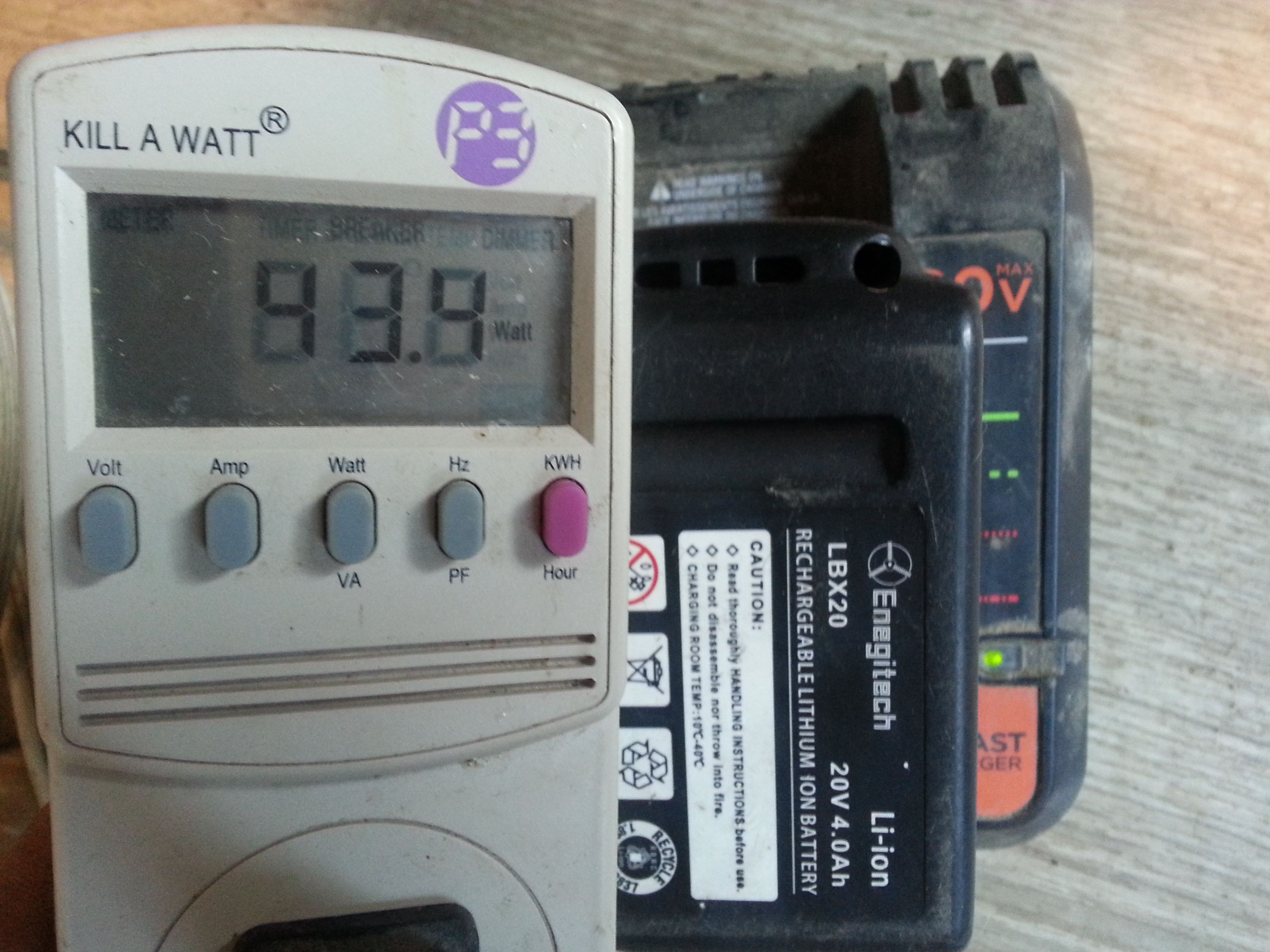
Link: Power Audit with the Kill-A-Watt Power Meter
Household Power Audit
A great way to calculate your daily power needs is with a power audit. The Kill-A-Watt power meter is a great way to audit the appliances and devices in the household to see how much power they really use. The link above to a previous post has more information about the Kill-A-Watt power meter use. The efficiencysmart.org's Efficiency Smart Usage Chart PDF File has the power usage of the most commonly used household appliances and devices - useful for a household power audit.
Power Inverters
Power inverters change the 12 volt DC battery power to a household Alternating Current for powering household appliances, devices, tools, pumps, and fans - anything that would plug into the wall outlet of a house. If you are wanting to power a high power device like an 1800 watt compressor, then you would want at least a 2500 watt power inverter to be sure the inverter can provide enough power. If you are only trying to charge a laptop, some power tools, and small devices, a 300 watt power inverter would be sufficient and more efficient.
Pure Sine Wave Vs. PWM Inverters
Pure Sine Wave inverters put out a cleaner electrical current than Pulse Width Modulation inverters. Some computers and electrical equipment may be sensitive to this. The electrically noisy PWM inverters have electrical waves that look like jagged up and down staircases - when compared to the smooth up and down curves of the pure sine wave inverters - see the picture below.
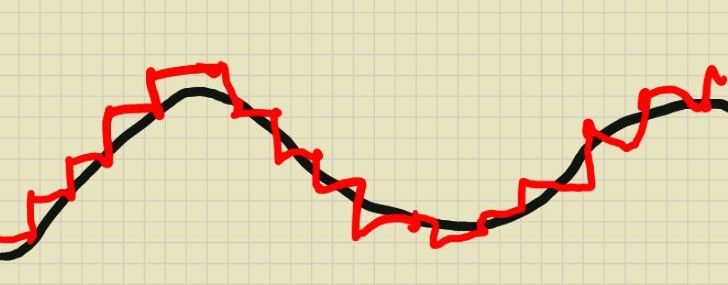
Link: Choosing the Right Inverter for Your Power Needs
I personally view PWM inverters as a short term solution and Pure Sine Wave inverters as a long term solution for more delicate electronics. For more information about power inverters, click the post link above.
Backup Generator and Battery Charger
It's always good to have a backup for many short cloudy days. A backup generator and battery charger help smooth out a solar power system that is being added to over time. I have a 3000 watt gasoline generator that powers a 70 amp -12 volt battery charger. Running the generator and charger for a hour fully charges up the 800 amp hour battery array. With a fully charged set of batteries the generator is turned off. The generator is decently efficient, it uses about a dollar worth of gasoline to run for an hour. Knowing How to Pull Start a Small Engine may be useful.
Off-grid Solar Power Strategy
The most difficulty with smaller battery storage systems have is running the refrigeration - because it could be running at any time, day or night. After the refrigeration can be kept running, most other appliances and devices can be run and charged during the daytime when there is ample power. Hot water we currently heat on the wood stove top in the winter and the rocket stove in the summer. On demand propane and small tank electric water heaters are possible substitutes. We currently use wood stove top, outdoor propane burners and pizza oven, and an electric bread machine for cooking. With enough solar panels, electric cooking could soon be an option. For clothes cleaning we have a small capacity and low power washer and spinner designed for apartments without laundry facilities. The clothes are hung outside to dry on the clothesline in the summer, or near the wood stove in the winter. As you can see, much of the solar power strategy is to use available electricity more efficiently and scheduling most of the power usage during the ample sunlight time of the day.
Global Homesteading Collective Radio Coming Soon...
 GHS Collective Radio
GHS Collective Radio
| 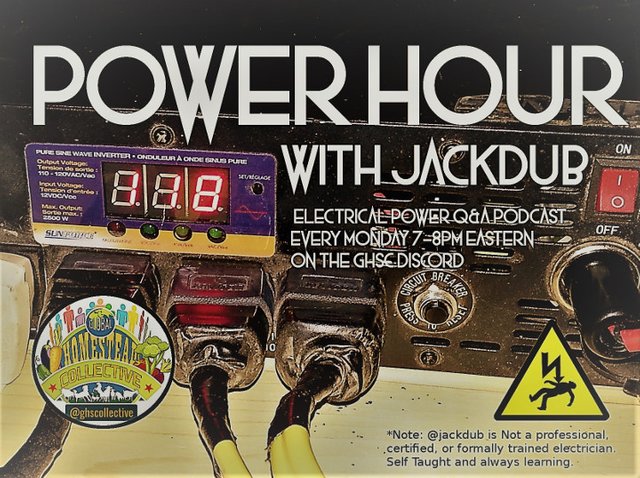 |
Many thanks to @ghscollective for the above podcast opportunity :)
Have a great day!
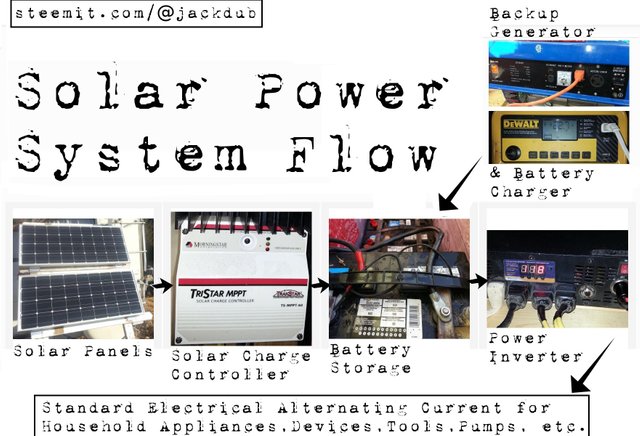



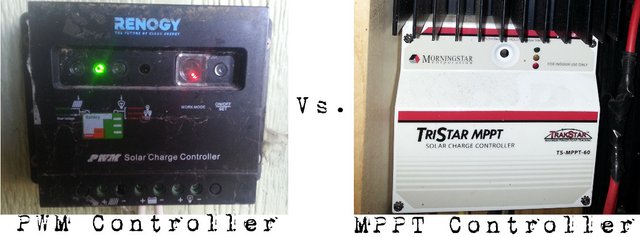

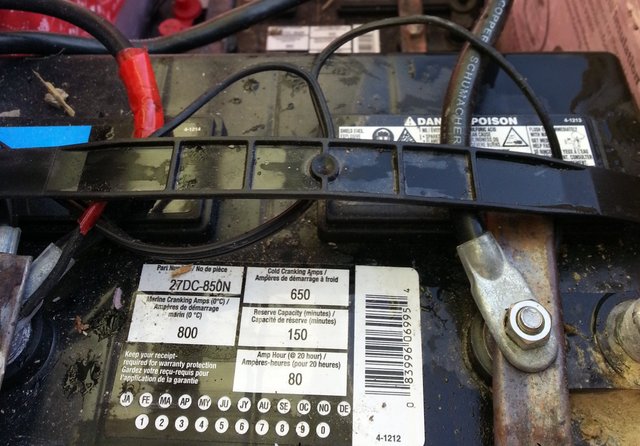





You did a good job with your system. I looked into it for our house and the cost came in at about 3X what you spent. It isn't an apples to apples comparison because I was looking at a grid-tie system designed and installed by others, but it is still a big difference.
How do you run a well pump on such a small inverter? We could run on about 3000 Watts most of the time, but our well pump will choke a 5500 Watt generator.
That is over 7 HP. Might want to have it checked? Is it a very deep well (1000 ft)?
The well pump I am looking at, is 500 watts rated at 1/2 HP and will raise from 200 ft.
But he did do a good job, on his solar system! A lot of people fall down on storage, but he has a good size.
:)The well is 270 feet and the pump is rated for 8A/230V. It never tripped the breaker on the generator, so I guess it was OK, but it was certainly a big load when it was starting up.
If I was seriously thinking about going off the grid I think I would shop around for a low current pump and put in a cistern. You could pump at a trickle all day long and keep the cistern full, then use and on-demand pressure pump like in an RV.
I like the way you think, that is what I am building! I already bought the on demand pump, and plan to use a couple of bulk container to keep 500 gallons up top.
The well will come in at 80 feet, and I will drill it about 40 feet deeper for the pump. We are 1/2 mile from a hydroelectric lake, so it won't dry up.
Nice! Have you thought about preventing algae growth in the bulk containers?
Yes I will paint them black. If that is not enough, and I have some growth, I have a UV source around a glass tube I will add; with a small circulating pump, to clean it up.
Currently I draw water from my cistern - down the hill to the cabin - with a 300 foot gravity powered siphon - it has stayed primed with a dpigot at the bottom of the hose for 3 weeks now lol :) We'll use a small pump when we build the main house. No current plans to put in a well, but our neighbors went down about 150 feet. Back when I was considering a well, I read that often the will driller will set people up with a pump that is much more powerful than really needed and to request or purchase a smaller power pump for offgrid. The air compressor and the hot tub pulled over 2000 watts - did not crush the inverter, but really drained the batteries. I disconnected the hot tub jets and heater :)
You sound like a hardcore off-grid guy. I could never talk my family into that.
I was always up for it, my wife had been on a few homesteader message boards for a little while and was having thoughts about it, and my 9 year old son enjoys the outdoors and all the extra time with retired mum and dad - and he still has his tablets and internet for down time (what most people would probably miss these days :) Extra work for me - keeping all the utilities available off-grid - which gets easier as more structure is built - but other than that we dont feel isolated or missing much from on-grid life. We just do things a little different now - a nice slower pace :)
This excellent post was included in the latest issue of The Inbox Runneth Over. Stop by when you have a minute and see what else I found along the trail. Your companions here are all interesting in their own way, and your support for this project and especially its occupants would be very much appreciated. Thank you for everything. Have a lovely day!
Glad to see my auto got this post already. Congrats. Great info here and laid out nicely. I'm all about off-grid power. We're heading that direction. I got our first little solar panel a few years ago just for charging mobile devices. I like the idea of having little portable options in addition to a home set up like this to save even more wear and tear and extend the life of these more expensive set ups. Not to say this is expensive. It's not in the grand scheme. I just like to factor in as much sustainability as I possibly can. Can't wait to get crackin' on our off-grid tiny house and make posts like this one. Keep it up!
Thanks @movement19 - It's great with all the new low-power devices, etc. My camper has a couple hundred watt panels on it with 200 or so amp hours worth of batteries - that setup will charge anything I throw at it - all day long .. laptops, usb battery packs, 20v tool battery packs, phones, etc .. I've never seen the battery get low. Some people are using propane fridges from campers for lightening the load on startup solar systems too.
Great walk through of your set-up and great set-up :) Good education for someone considering doing a solar system by themselves.
Thanks - that was the goal with that solar power system flow info graphic - to simplify the process. There are a lot of options, but the flow of the system isn't too complicated once it's broken down to the basic elements :)
very cool !!! love the setup, how are you online if you live offgrid? 😮😆🤣
thats why i cant completely doit yet! i need steemit too badly 👽
We're off-grid but not off-wireless :) We're in cottage country so we have a wireless router that gets internet from the cell phone towers. 1 Mbps download speed and 100 gig a month for data. The family watches a lot of netflix and youtube etc - we get by :)
@jackdub oh okay coo, bc that's not something i like to consider. i almost rented a place way up in the mountains and purchased but no phone, no internet is a bit tough for me. not unless it goes out when SHTF okay but until then ... LOL i'm bloggin!
hehe netflix and YT, sounds like my life. :)
Your system looks solid. Have you considered wind for the cloudy days? What led you to 12 volts instead of 24 volts? Where is your low voltage on the Batteries set?
Great post! I am going solar as soon as we get to the land we bought. I have all the hardware except the battery bank, only about a third of those so far.
Thanks - 12 volt is kind of a standard because that's what many cars, boats, motor homes and trucks use - so many 12 volt accessories and appliances. I also thought it was a simpler battery array setup. You need a lot of strong wind or a very expensive turbine to produce a useful amount of power. Especially where I live, the money would be better spent on more solar panels. Congrats on going offgrid soon :)
The inverters were harder to find, but about the same cost. Since I am building the battery sticks that part was easy for me, by 12 volt is a direct build with lead acid batteries. I like your system, looks solid.
Wind is a little more reliable here, especially next to the lake. I will be buying a 1700 watt wind generator, but at my average wind velocity, it will make 400 to 500 watts.
The value is, that when the solar panels drop off, the wind generator picks up. This will give me more consistent power input. I have 2500 watts of panels, and will add more after the basic system is going (and I have time to build the extra panels)
:DThat's a nice size turbine - I have a small 400 watt one. Be sure you get a MPPT charge controller for the turbine of course - even more crutial than with solar :)
Were most people have trouble with a wind generator, is that they expect the rated output all the time, but never look at what it will actually produce at their location. So they, in this case, plan on the unit to make 1700 watts all the time. When it makes 450 watts, they feel like it is not working. The added benefit is that when the sun goes down, the wind still blows.At 450 watts over 24 hours, it will add over 10,000 watts a day to the batteries.
I have the parts for a 2000 watt dump load for this system, to avoid overcharge. A good controller is critical on any wind generator system, and that is a good choice! :)
The other reason for the 24 Vdc, is that I intend to add a 24 volt wiring buss to the house, and I can get more power delivered at 24 volts. I will run the 24 volt in the old central heat and air ducts. 24volts is the highest voltage that is code to run outside of conduit. 48 volts would be too expensive to wire, because of the need for conduit, and the 48 volt inverters are a lot more money.
I'm starting to build a house up on top of the hill, near the cistern this summer. Will be wiring it standard 120v AC. No solar panels on the roof. Behind the house, besid the cistern will be an insulated 10x10ft structure that will have the solar panels on it's roof, the battery bank will be inside, the inverters will be inside to invert the 12v to 120vAC to send over to the house. I could easily connect to the grid that is 40 yards away - at the end of the driveway - but I will not :)
Good for you! This house is already hooked up to the grid, but as soon as I get the solar system setup, I will fire the power company!
:)Nice nuts and bolts, off the shelf system. Great for someone who wants to learn how to put a system together without going to Tesla.
I also liked the references to other sources and previous articles for more in-depth analysis. This article is well rounded and speaks to the layman about the practical application of solar power.
So this is what it is like to live off the grid...
Thanks - I started with half of the system I have now, it was nice to see it smooth out and become much easier to manage as I added more panels and batteries. The backup generator and battery charger were the key pieces that completed the hybrid system - really helping with morale as much as backup electricity - ole faithful in the winter - just knowing it was there was a load off :)
Nice nuts and bolts, off the shelf system. Great for someone who wants to learn how to put a system together without going to Tesla.
I also liked the references to other sources and previous articles for more in-depth analysis. This article is well rounded and speaks to the layman about the practical application of solar power.
So this is what it is like to live off the grid...
This is very interesting to me, considering there is TOO MUCH sunshine where I live.
Also coincidentally I recently just watched a video about the Tesla Wall and learned a bit more about solar powered homes.
Good sharing!
Nice! Looks like you have the same Solar Panels as me lol, although mine is a smaller system.
I use an MPPT controller, Pure SineWave 1500w inverter and 500amps of battery bank... i also have a Pure SineWave Generator as a back-up... My Pure SineWave Inverter will not accept any other type of modified sinewave input though.
Great article JD.... It's great not be be connected to the grid and independent lol..
Freeedom!! That sounds like a solid setup @preppervet - livin la vida off-grid :)